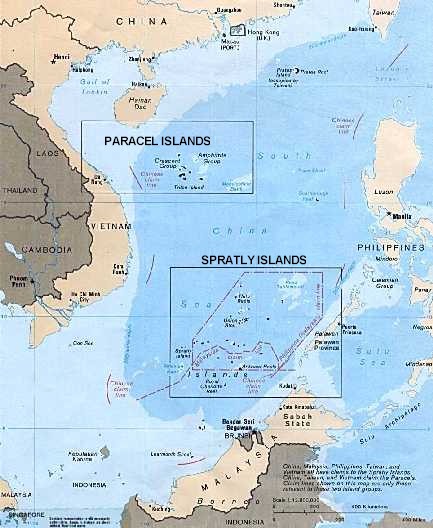

Status Quo Side: Vietnam et al.
Non-Status Quo Side: China
Region: Pacific, East Asia & SE Asia
Conflict Type: Interstate
Issues in Dispute: Resources, Territory
Maps:
Spratly
Islands 1999 (29K)
Paracel Islands 1999
(26K)
Paracel and Spratly Islands 1988
(229K)
South China Sea Islands 1988 full size
(229K)
Asia
maps in UTexas collection
Possession of two island archipelagos in the South China Sea (the Paracels some 200 miles southeast of Hainan, and the Spratlys 500 miles south of the Paracels) has long been disputed. China's claims date from the 15th century, Vietnam's from the 17th. Japan's defeat in WWII reignited sovereignty claims and placement of military garrisons. At stake are rich tuna and other migratory fishing grounds, geo-strategic basing locations and, since the early 1970's, potentially vast oil resources. During the 70's, the Philippines, Republic of China (Taiwan), Malaysia and Brunei claimed specific islands in the Spratly group, all but the latter installing garrisons. CPR (Chinese Peoples' Republic) claims became increasingly militant as speculation for oil (including Western exploration granted by the South Vietnamese) increased, and as geostrategic conditions changed with a declining US presence in Southeast Asia, and a perceived increase in the Soviet threat via then Soviet-supported Vietnam.
In January 1974 CPR forces attacked Vietnamese garrisons in the Paracels, citing harassment of Chinese fishermen settled on the islands. The Vietnamese retreated south to the Spratlys while China increased its civilian and military presence in the Paracels. Sovereignty remained in dispute as China's consolidation of control shifted the focus of the dispute to the Spratlys. Occasional naval skirmishes broke a tense peace as all sides sought support for conflicting claims. In the 1980s , the Vietnamese lost ground when many countries, including the Soviet Union, refused to back its claims. In early 1988, a naval clash with Vietnam left China in control of 6 more islands and reefs for a total of nine. Diplomatic relations between China and Vietnam, broken for a decade, were resumed in 1991. In February 1992 China granted an oil exploration concession to a US company in an area also claimed by Vietnam, prompting ASEAN to call on all claimants to resolve the dispute peacefully. In April 1994, when Vietnamese gunboats escorted a Chinese research vessel from a disputed oil exploration region, China made no public comment. But later it built military structures on Mischief Island within the Philippines' 200-mile zone.
China in April 1995 assured the US that its territorial claims were not meant to impede freedom of navigation or safe passage of ships and aircraft. In July the Philippines announced support for declaring the Spratlys a marine reserve, thereby blocking oil exploration, and in August agreed with China to reject the use of force in settling the dispute. In October China, Taiwan and ASEAN members (now including Vietnam) agreed to cooperate on navigation, shipping and communications and establish bilateal "codes of conduct" in the South China Sea. China meanwhile ratified the Law of the Sea Convention but asserted legally dubious baselines around the Paracels, announced new claims in May 1996, and refused to vacate Mischief Reef.
In 1999, China stepped up construction of a military base in the Paracels and expanded a military installation in the Spratleys, both potentially worrisome in light of China's mounting pressure on Taiwan to reunify with the mainland.